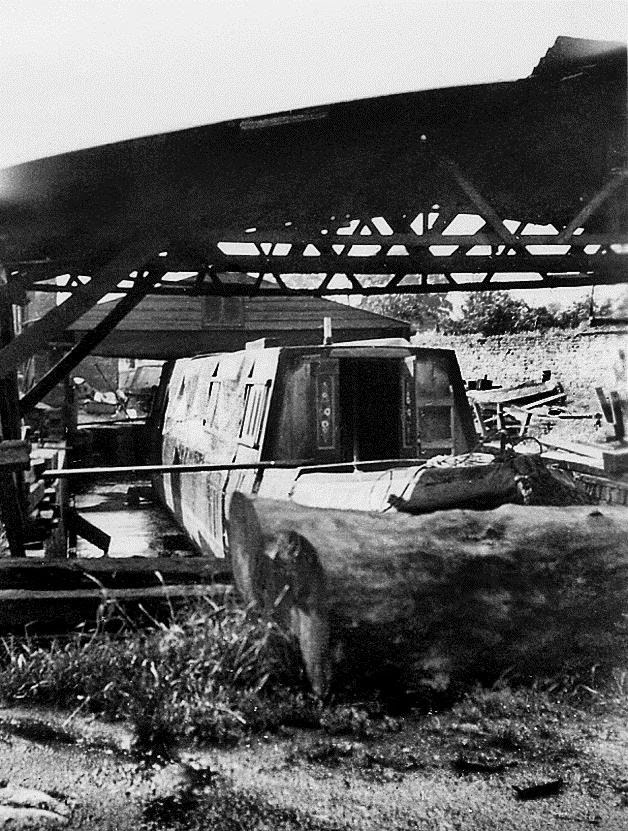Following the publication of
Narrow Boat in 1946,
Tom Rolt’s converted Shropshire Fly Boat,
Cressy, became the most famous of all canal boats but unfortunately she was not to last long. Following the well-known differences between
Aickman and Rolt that split the
Inland Waterways Association (IWA) and the acrimonious
Market Harborough Rally in 1950, Tom Rolt took Cressy to Banbury for the winter. Not only had his relationship with the IWA and his marriage to Angela deteriorated but he was to find that the condition of
Cressy had also become critical. This sad period in his life is reported in detail in his autobiography
Landscape with Canals.
was moved to Stone in the spring of 1951 to be in the care of
Rendel Wyatt. After an attempt at selling her failed because a survey had shown her wooden hull to be rotten, she was towed to a backwater of the Trent & Mersey, left to sink and rot; eventually she was broken up and burned. Rolt never enquired about her whereabouts and did not want to see her again.
Cressy had not only been part of Tom and Angela Rolt’s life since 1939 but she had been part of Tom’s family as early as 1929 when his uncle
Kyrle Willans had bought her. She was converted by Willans from a horse boat to steam power and it was with
Cressy in this form that Tom Rolt and his uncle took a two-week cruise.
There are only a few readily available images of
Cressy. Some are shown in later editions of
Narrow Boat and some are in
Ian Mackersey’s book Tom Rolt the Cressy Years. So it was with great interest that I found what is claimed to be a photograph of
Cressy on the front cover of one the editions of
Windlass in my bound volume. Not only does the photograph purport to be of
Cressy but it’s title is rather tragically, “Sinking of the Cressy”. The edition (Volume 22) of
Windlass was evidently published in February 1961, although the printer dated it as January.
Cover of Windlass, January 1961
The boat shown in the photograph (above) appears to be lying in a rather perilous state and it looks like it could be
Cressy. The editor, Michael Baldey, notes in his column that the picture is a sad one and that it “depicts the tragedy of
Cressy, player in the title role of Mr Rolt’s classic “
Narrow Boat”. He notes in his column that he has no details of the photograph but that it “came unexpectedly into our hands”. There is some obvious doubt in his mind about authenticity since he comments “if anybody could lighten us further...”
The following issue of
Windlass has two letters referring to the cover photograph. One relates a story of the demise of
Cressy which is similar to that reported in
Landscape with Canals but the second from an anonymous reader, titled “Quite Sure?” points out that the boat in the photograph looks different in some ways from the cabin plan published in
Narrow Boat and different from his recollections from seeing her at the top of Tardibigge Flight some sixteen years earlier.
Cressy in 1946 at Tardebigge - note the lack of fore-cabin and location of chimney
There are obvious differences between the photographs of
Cressy published in later editions of
Narrow Boat and the boat in this photograph. They include the location of the chimney, the fore cabin and the large ship-styled ventilators. My first reaction was that the photograph was indeed not of
Cressy, but I decided to investigate further.
As a subscriber to the magazine
Narrowboat I looked through the index and found a very interesting article by Hugh Potter who wrote in the Spring 2010 issue about the time that
Cressy was not in the hands of the Rolt and Willans families. Potter describes the time between 1930 and 1936 when
Cressy belonged to a Leicester journalist, John Fortune. Very helpfully the article included a photograph of
Cressy complete with a fore-cabin and a chimney in the same location as in the
Windlass article. Although not very clearly the large ventilators are visible near the stern. A water barrel is on the fore-cabin. I rexamined the
Windlass cover and found that it was also present there.
Cressy when owned by John Fortune 1930-36
(from Narrowboat Magazine)
Stern view of Cressy when owned by John Fortune 1930-36
(from Narrowboat Magazine – web site)
So there we have it. It appear the mystery photograph used on the cover of
Windlass back in 1961 was indeed of
Cressy. Although the boat in the photograph is beached, its attribution to the last days of
Cressy (its “sinking”) is certainly wrong; it survived many more years following this incident. I wonder if this photograph relates to one of the articles, reported by Hugh Potter, that Fortune wrote for the
Illustrated Leicester Chronicle and
Motor Boat and Yachting.
Although a major problem with the
Windlass photo appears to have been resolved, there is still a mystery as to where the
Windlass photo was taken and why
Cressy is in this position. The location looks like a river navigation but why was
Cressy beached? In the
Narrowboat article Potter mentions that Fortune ran aground near Leicester when travelling south and
Cressy later had a rope around her propeller; this looks a bit more serious.






.jpg)









